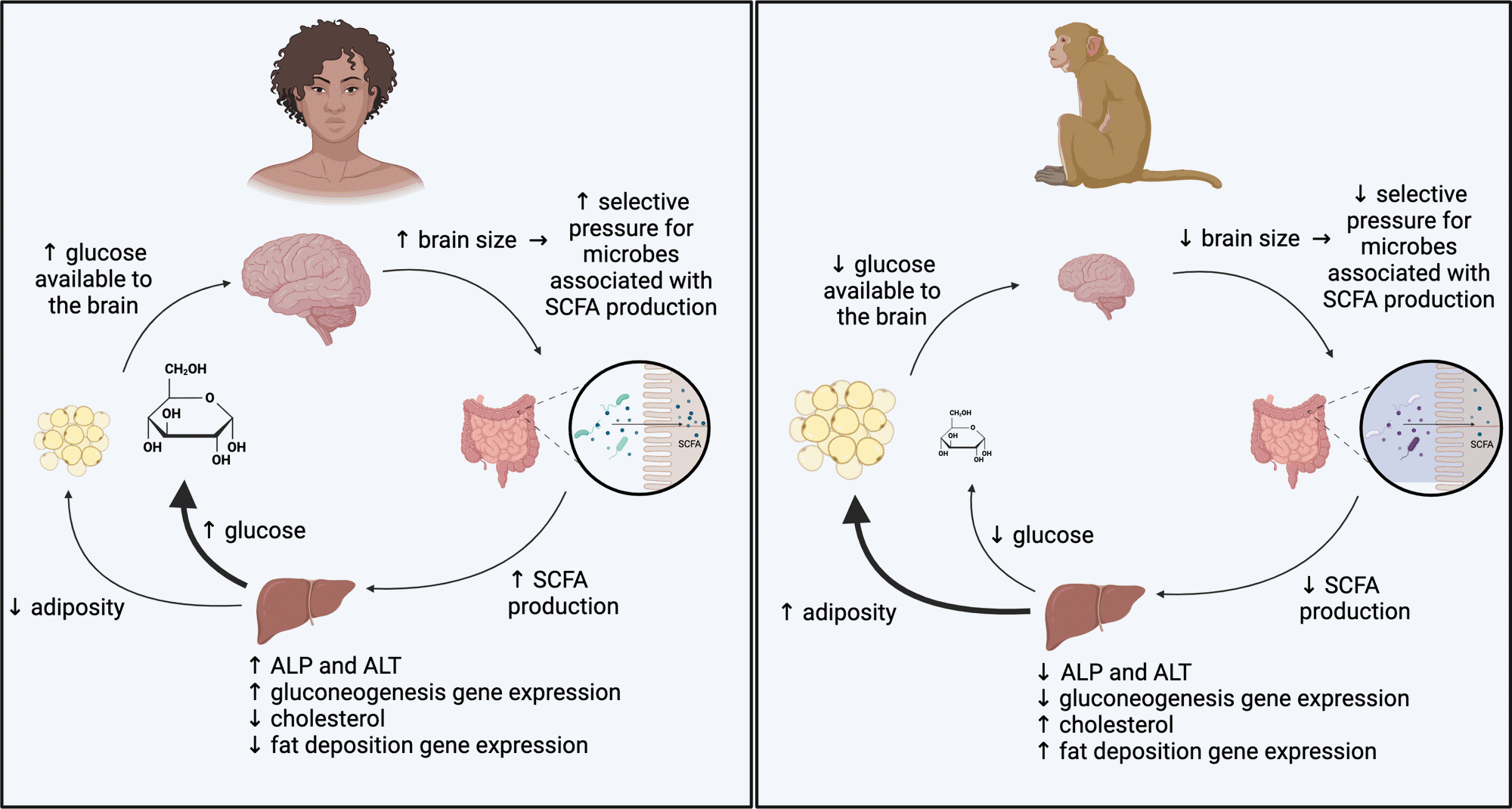Researchers reveal how gut microbes shape metabolic strategies to fuel larger brains, offering a glimpse into the evolutionary biology of primates.
Putative model for microbial influences on the metabolism of high-EQ and low-EQ primates. Our findings indicate microbially mediated pathways through which the metabolism of high-EQ primates is biased towards energy production and the metabolism of low-EQ primates is biased towards energy storage.
In a recent study published in the journal Microbial Genomics, researchers in the United States investigated the role of the gut microbiome in influencing host metabolism across species, focusing on primates with varying brain sizes. They transferred gut microbiota from humans, squirrel monkeys, and macaques to germ-free mice and examined how microbial communities contribute to metabolic traits that may be linked to brain energy demands and evolution.
Background
Large brains are energetically costly, especially in primates, where brain size often correlates with increased metabolic demands. Humans, with the largest brain-to-body size among primates, show adaptations such as higher glucose metabolism to sustain these energy-intensive organs. However, the mechanisms driving such metabolic variations across species are poorly understood.
Existing research has reported the involvement of genetic and epigenetic factors in these metabolic variations, but their connection to systemic metabolism remains unclear. The gut microbiome is a vital regulator of host metabolism and produces metabolites such as short-chain fatty acids (SCFAs) that influence energy storage, glucose production, and fat metabolism. Furthermore, while its role in metabolic diseases, including diabetes, is recognized, its contribution to interspecies metabolic differences, especially related to brain energy demands, is less explored.
About the Study
In the present study, the scientists hypothesized that differences in the gut microbiota mediate metabolic strategies and balance the energy needs for brain function against those for growth and maintenance in primates with varying brain sizes. The researchers conducted an experiment using germ-free mice to investigate how the gut microbiome influences metabolism in hosts with different brain sizes.
The gut microbiota of three primate species, humans, squirrel monkeys, and macaques, was transplanted into the germ-free mice to evaluate the effects of microbial differences on host metabolism. Humans and squirrel monkeys were chosen as “brain-prioritizing” species due to their larger brain sizes relative to body size, while macaques served as a comparison with a lower brain-to-body size ratio.
Fecal samples from healthy adult primates, free of antibiotics, were collected, processed, and used to inoculate germ-free mice orally on a standardized diet for 60 days. Weekly assessments included weight measurements, food consumption, and metabolic evaluations, with fecal and blood samples collected for microbiome and metabolite analyses. A glucose tolerance test was administered to measure glucose regulation, and the mice underwent magnetic resonance imaging scans to assess body fat distribution.
The researchers also used metagenomic and metabolomic analyses to identify specific microbial pathways and metabolites contributing to host metabolic traits. High-resolution imaging and ribonucleic acid (RNA) sequencing of liver tissues provided insights into organ-specific metabolic responses. The microbial composition in the mouse gut was analyzed through 16S ribosomal ribonucleic acid (rRNA) sequencing, while metagenomic techniques quantified SCFA production and microbial functional pathways.
Results
The results showed that the gut microbiome significantly influences host metabolism in ways consistent with the brain size of the primate species. Mice inoculated with gut microbiota from high-brain-to-body size species, such as humans and squirrel monkeys, exhibited increased energy expenditure, higher fasting glucose levels, and enhanced gluconeogenesis. Conversely, the mice inoculated with microbiota from macaques showed greater fat accumulation and weight gain.
Furthermore, the mice with microbiota from species with greater brain size consumed more food but displayed lower body fat percentages and slower weight gain. Elevated levels of SCFAs, such as acetate and propionate, were also observed in these mice, suggesting a microbial contribution to increased glucose production and reduced fat storage.
Metagenomic analysis revealed that microbial pathways associated with energy production, such as fucose and pyruvate metabolism, were more abundant in high-brain-to-body size microbiota. Additionally, the expression of the genes associated with liver function in these mice revealed enrichment for pathways related to energy production, such as lipid metabolism and gluconeogenesis. These changes indicated metabolic programming aimed at prioritizing energy for brain function.
In contrast, mice inoculated with macaque microbiota exhibited microbial pathways favoring energy storage. Their microbiome produced lower SCFA concentrations and exhibited functions aligned with fat deposition and decreased glucose production. These differences suggested a trade-off between energy allocation to the brain versus adipose tissues.
Interestingly, human microbiota-inoculated mice showed unique metabolic profiles, with the highest fasting glucose and propionate levels, aligning with humans’ exceptional brain energy demands. Despite consuming more food, these mice had minimal weight gain, further emphasizing the role of the gut microbiota in metabolic regulation. Overall, the results highlighted the gut microbiome’s ability to modulate host energy allocation strategies, reflecting the metabolic needs of the brain size of the host species and the associated energy demands.
Conclusions
To conclude, the study demonstrated the vital role of the gut microbiome in shaping host metabolic strategies and supporting the energy demands of larger brains in primates. The findings suggested that microbial communities influence glucose production, fat storage, and energy allocation, providing insights into evolutionary adaptations in brain size.
The researchers noted that their findings provide a foundation for exploring how microbiomes contribute to species-specific life history traits, such as growth, reproduction, and longevity. Future studies could investigate microbiome-host interactions during early developmental stages when brain energy demands peak.
Journal reference:
- Mallott, E. K., Kuthyar, S., Lee, W., Reiman, D., Jiang, H., Chitta, S., Alexandria, W. E., Layden, B. T., Sumagin, R., Manzanares, L. D., Yang, G.-Y., Luisa, M., Gray, S., Williams, L. E., Dai, Y., Curley, J. P., Haney, C. R., Liechty, E. R., Kuzawa, C. W., & Amato, K. R. (2024). The primate gut microbiota contributes to interspecific differences in host metabolism. Microbial Genomics, 10, 12. DOI:10.1099/mgen.0.001322,
Source link : News-Medica

